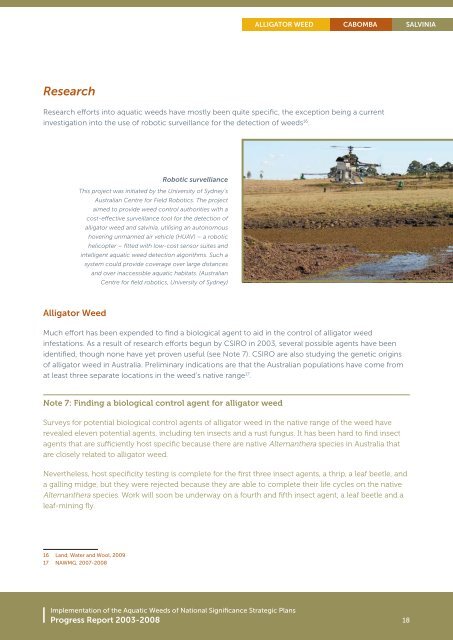implementation of the aquatic Weeds of national ... - Weeds Australia
implementation of the aquatic Weeds of national ... - Weeds Australia
implementation of the aquatic Weeds of national ... - Weeds Australia
Create successful ePaper yourself
Turn your PDF publications into a flip-book with our unique Google optimized e-Paper software.
Alligator Weed<br />
Cabomba<br />
Salvinia<br />
Research<br />
Research efforts into <strong>aquatic</strong> weeds have mostly been quite specific, <strong>the</strong> exception being a current<br />
investigation into <strong>the</strong> use <strong>of</strong> robotic surveillance for <strong>the</strong> detection <strong>of</strong> weeds 16 .<br />
Robotic survelliance<br />
This project was initiated by <strong>the</strong> University <strong>of</strong> Sydney’s<br />
<strong>Australia</strong>n Centre for Field Robotics. The project<br />
aimed to provide weed control authorities with a<br />
cost-effective surveillance tool for <strong>the</strong> detection <strong>of</strong><br />
alligator weed and salvinia, utilising an autonomous<br />
hovering unmanned air vehicle (HUAV) – a robotic<br />
helicopter – fitted with low-cost sensor suites and<br />
intelligent <strong>aquatic</strong> weed detection algorithms. Such a<br />
system could provide coverage over large distances<br />
and over inaccessible <strong>aquatic</strong> habitats. (<strong>Australia</strong>n<br />
Centre for field robotics, University <strong>of</strong> Sydney)<br />
Alligator Weed<br />
Much effort has been expended to find a biological agent to aid in <strong>the</strong> control <strong>of</strong> alligator weed<br />
infestations. As a result <strong>of</strong> research efforts begun by CSIRO in 2003, several possible agents have been<br />
identified, though none have yet proven useful (see Note 7). CSIRO are also studying <strong>the</strong> genetic origins<br />
<strong>of</strong> alligator weed in <strong>Australia</strong>. Preliminary indications are that <strong>the</strong> <strong>Australia</strong>n populations have come from<br />
at least three separate locations in <strong>the</strong> weed’s native range 17 .<br />
Note 7: Finding a biological control agent for alligator weed<br />
Surveys for potential biological control agents <strong>of</strong> alligator weed in <strong>the</strong> native range <strong>of</strong> <strong>the</strong> weed have<br />
revealed eleven potential agents, including ten insects and a rust fungus. It has been hard to find insect<br />
agents that are sufficiently host specific because <strong>the</strong>re are native Alternan<strong>the</strong>ra species in <strong>Australia</strong> that<br />
are closely related to alligator weed.<br />
Never<strong>the</strong>less, host specificity testing is complete for <strong>the</strong> first three insect agents, a thrip, a leaf beetle, and<br />
a galling midge, but <strong>the</strong>y were rejected because <strong>the</strong>y are able to complete <strong>the</strong>ir life cycles on <strong>the</strong> native<br />
Alternan<strong>the</strong>ra species. Work will soon be underway on a fourth and fifth insect agent, a leaf beetle and a<br />
leaf-mining fly.<br />
16 Land, Water and Wool, 2009<br />
17 NAWMG, 2007-2008<br />
Implementation <strong>of</strong> <strong>the</strong> Aquatic <strong>Weeds</strong> <strong>of</strong> National Significance Strategic Plans<br />
Progress Report 2003-2008<br />
18

















